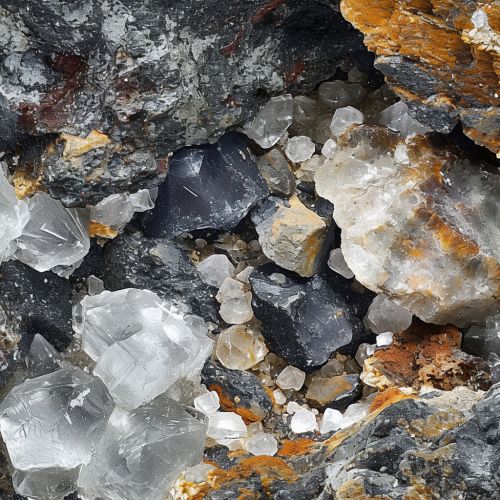Mineral resources
Overview
Mineral resources are naturally occurring substances that are solid and inorganic, representable by a chemical formula, usually abiogenic and ordered in an atomic structure. They are valuable for their physical and chemical properties, and are extracted from the Earth's crust for a variety of uses. Mineral resources include metals such as gold, silver, and copper; non-metals such as gypsum, limestone, and talc; and energy minerals like coal, oil shale, and uranium.
Classification of Mineral Resources
Mineral resources can be classified into two main categories: Metallic and Nonmetallic.
Metallic Minerals
Metallic minerals are minerals which contain one or more metallic elements. They are characterized by their shiny or metallic luster and their ability to conduct heat and electricity. Examples of metallic minerals include gold, silver, copper, nickel, and iron.
Nonmetallic Minerals
Nonmetallic minerals, on the other hand, do not contain metallic elements and do not have a metallic luster. They are not good conductors of heat and electricity. Examples of nonmetallic minerals include gypsum, limestone, talc, and salt.
Formation of Mineral Resources
Mineral resources form through various geologic processes. These processes include the cooling of magma or lava to form igneous rocks, the accumulation of sediment to form sedimentary rocks, and the alteration of existing rocks by heat and pressure to form metamorphic rocks.


Extraction and Processing of Mineral Resources
The extraction of mineral resources involves several steps. These steps include prospecting, exploration, development, extraction, processing, and reclamation.
Prospecting and Exploration
Prospecting is the first step in the extraction process. This involves searching for mineral deposits in a place where ore is known to be present. Exploration involves the physical search for minerals, which can be done through drilling, trenching, and aerial surveys.
Development and Extraction
Once a deposit is found, the next step is development. This involves preparing the area for mining by building roads and infrastructure. The extraction process then begins. This can involve open-pit mining, underground mining, or placer mining.
Processing and Reclamation
After the ore is extracted, it is then processed to extract the valuable minerals. This can involve crushing the ore, separating the minerals from the ore, and further refining. Once the mining process is complete, the mine site is reclaimed to minimize environmental impact.
Uses of Mineral Resources
Mineral resources have a wide variety of uses in society. Metallic minerals are commonly used in industries such as construction, manufacturing, and technology. Nonmetallic minerals are used in industries such as agriculture, construction, and energy production.
Uses of Metallic Minerals
Metallic minerals are used in a wide variety of industries. For example, gold is used in jewelry and electronics; copper is used in electrical wiring and plumbing; and iron is used in construction and manufacturing.
Uses of Nonmetallic Minerals
Nonmetallic minerals also have a wide variety of uses. For example, gypsum is used in the manufacture of drywall; limestone is used in the manufacture of cement; and salt is used in food preservation.
Environmental Impact of Mineral Extraction
The extraction of mineral resources can have significant environmental impacts. These impacts can include habitat destruction, water pollution, air pollution, and soil erosion. In addition, the extraction of fossil fuels can contribute to climate change.
